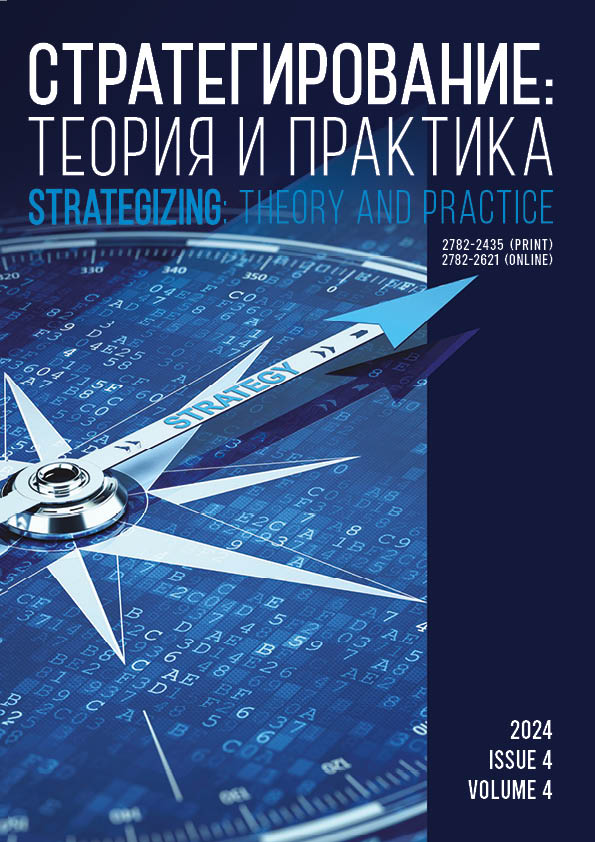Kemerovo State University
Kemerovo, Kemerovo, Russian Federation
UDC 303
aches to agglomeration development often fail to meet the principles and rules of strategizing. The article describes the open diffuse agglomeration as a new approach that complies with the general theory of strategy and methodology of strategizing: it is innovative, asymmetric, and competitive in terms of time factor. The research relied on the system-structural approach and the theories of dirigisme and spatial diffusion of innovations. The author appealed to the general theory of strategy and the methodology of strategizing developed by Professor V. L. Kvint. An open agglomeration means that it covers all or most settlements in the region. As a result, the entire region is integrated into one or several agglomerations. This approach engages all municipalities into the agglomeration process, thus preventing spatial inequality. In addition, it structures the processes of strategic and tactical management, settling, migration, housing construction, and infrastructural development. A diffuse agglomeration means that it uses the mechanisms of active internal interaction to spread positive growth impulses from the center to the periphery, i.e., diffusion of innovations, demand, business activity, etc. The strategizing of an open diffuse agglomeration requires a preliminary assessment stage. The analysis of values and interests provides a relevant set of forecasts to scan the windows of opportunity of the external environment.
strategy theory, strategizing methodology, strategic priorities, open diffuse agglomeration, regional economy, growth centers, system complexity, system structure
1. Breslavsky AS. Possible Modes of Suburbanization in Russia. Mir Rossii. 2016;25(1):79–102. (In Russ.)
2. Gegel GVF. Science of Logic. St. Petersburg: Nauka, 1997. 800 p. (In Russ.)
3. World Development Report 2009. Reshaping economic geography. Moscow: Ves’ Mir; 2009. 410 p.
4. Kvint VL. The Concept of Strategizing. Kemerovo: Kemerovo State University; 2022. 170 p. (In Russ.) https://doi.org/10.21603/978-5-8353-2562-7
5. Kvint VL. The Concept of Strategizing. Vol 1. St. Petersburg: NWIM RANEPA; 2019. 132 p. (In Russ.)
6. Kvint VL. Theoretical Basis and Methodology of Strategizing of The Private and Public Sectors of The Kuzbass Region as A Medial Subsystem of The National Economy. Russian Journal of Industrial Economics. 2020;13(3):290–299. (In Russ.) https://doi.org/10.17073/2072-1633-2020-3-290-299
7. Kireev AA. Agglomeration as a Tool and a Problem (Notes on the Margins of “Spatial Development Strategy of the Russian Federation”). Regionalistica. 2020;7(3):71–78. (In Russ.) https://doi.org/10.14530/reg.2020.3.7
8. Kuratova LA. Configuration of the regional digital space (the case of the Komi Republic). PNRPU Sociology and Economics Bulletin. 2023;(1):159–175. (In Russ.) https://doi.org/10.15593/2224-9354/2023.1.12; https://www.elibrary.ru/RYRWAR
9. Lasuen JR. Urbanisation and Development – the Temporal Interaction between Geographical and Sectoral Clusters. Spatial Economics. 2009;(4):106–125. (In Russ.)
10. Saveleva NK, Sozinova AA, Makarova TV, Shpengler AV, Barmina EA. Normative and legal problems of regulating the agglomeration creation and activity at the regional level. Journal of Economics, Entrepreneurship and Law. 2023;13(3):733–746. (In Russ.) https://doi.org/10.18334/epp.13.3.117394
11. Garnaga AF, Okhotnikova YuV, Gromenko IV, Tyukavkina IL, Savkova NV. Suburbanization processes in Russia and world. The reasons. Features. Sociology. 2020;(6):84–87. (In Russ.) https://www.elibrary.ru/VAZTXC
12. Rogova KV, Sycheva-Peredero OV. Intraregional shifts in Entrepreneurial Activity of Kemerovo region – Kuzbass during Pandemic and Geopolitical Changes of 2020–2022. Bulletin of Kemerovo State University. Series: Political, Sociological and Economic Sciences. 2023;8(4):507–521. (In Russ.) https://doi.org/10.21603/2500-3372-2023-8-4-507-521
13. Seredyuk IV, Korchagina IV. Agglomeration as a Strategic Track for the Regional Development: Prospects and Limitations. Strategizing: Theory and Practice. 2023;3(4):379–392. (In Russ.) https://doi. org/10.21603/2782-2435-2023-3-4-379-392
14. Boodeville J-R. Polarization and urbanization (the Canadian and French examples). Économie Appliquée. 1975;28(1):215–241. https://doi.org/10.3406/ecoap.1975.3014
15. Chesbrough H. Open Business Models: How to Thrive in the New Innovation Landscape. Boston: Harvard Business School Press; 2006. 278 p.
16. Friedmann J. A general theory of polarized development. The Ford Foundation. Urban and regional advisory program in Chile. Santiago; 1967. 78 p.
17. Hägerstrand T. Innovation diffusion as a spatial process. Chicago: University of Chicago Press; 1967. 334 p.
18. Perroux F. A New Concept of Development. Basic Tenets. London: Routledge; 1983. 244 p.
19. Pottier P. Axes de communication et développement économique. Revue économique. 1963;14(1):58–132.
20. Schlagwein D, Conboy K, Feller J, Leimeister JM, Morgan L. “Openness” with and without Information Technology: A Framework and a Brief History. Journal of Information Technology. 2017;32(4):297–305. https://doi.org/10.1057/s41265-017-0049-3







